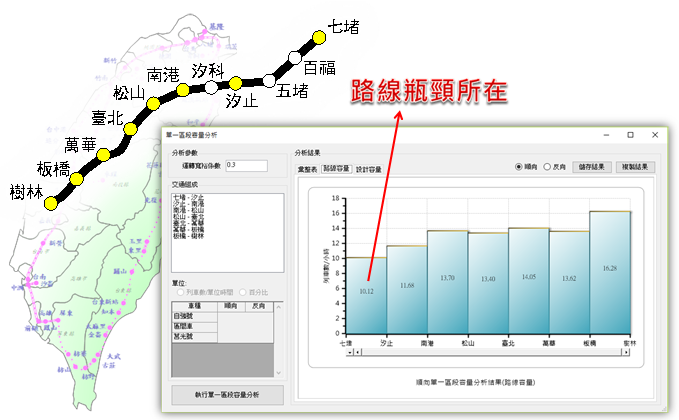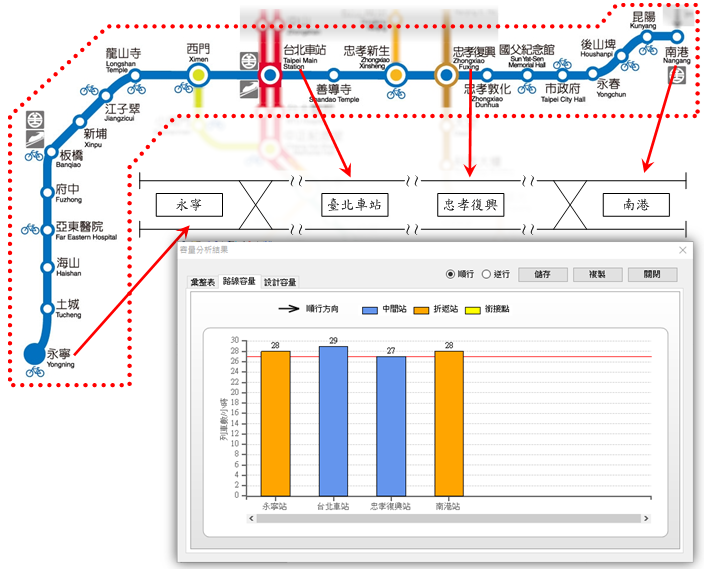Track capacity analysis method and software application
- Date:2019-03-06
- Update:2019-03-06
- Department:IOT
Project Overview:
“Track capacity” refers to “the maximum number of trains or passengers passing through a specific route interval per unit time under specific operating conditions”. Taking the capacity of the Taiwan Railways route as an example, the impact factors include the route conditions (such as: number of tracks between stations, distance between stations, route geometry conditions, number of connecting routes, number of railroad switches, configuration of the crossing lines, tracks and platform layout in the station), traffic conditions (such as: train functions, train type composition, direction distribution, station stopping times and stopping types) and control conditions (such as: train operation and control mode, blocking system, blocking interval length, signaling configuration) Capacity analysis can be used to estimate the transportation capacity of a track system under certain operating conditions, and can also be used to evaluate the impact of different facility configurations and operating conditions on the track capacity, to propose appropriate operational strategies.
This Institute has maintained a series of research on track capacity since 2003 and has constructed capacity models for the traditional and regional railway system (i.e., the Taiwan Railways System) and the Metro Rapid Transit System, and developed capacity analysis software. In 2013, this Institute compiled the "2013 Taiwan Railways Capacity Manual", used as a reference for analysis and decision making by government, industry, academia, and research institutes.
Research outcomes:
(1)Constructed the capacity models for the Taiwan Railways System and the Metro Rapid Transit System and developed the capacity analysis software: The The “Taiwan Railways System Capacity Model and Software” developed in this research can be used to evaluate and analyze in every instance of the capacity of a single segment and a continuous segment of a double-track (including bottlenecks), sensitivity, reliability, and capacity of single-line continuous segments and other related topics. The the "Metro Rapid Transit System Capacity Model Software" can analyze the busiest intervals, turn back stations, transfer station bottleneck points, overall road network capacity, and the impacts of the side line level crossings on the main line capacity. The aforementioned research outcomes have been compiled into a capacity manual, expanded and promoted use by all sectors.
(2)The practical applications of the capacity analysis technology of this research in track planning, design and construction phases: The capacity model and software constructed in this research have been verified as feasible through practical cases. The capacity analysis technology can be applied not only to evaluate the track system operation strategy during the planning phase, but also to evaluate the service performance of track system during the design and operation phases.
Promotion of Outcomes and Benefits:
(1)The project has organized multiple educational trainings during the research period.
(2)This Institute is in the process of revising the traditional railways capacity analysis software. After completion in 2018, the Taiwan Railways Administration, Railway Reconstruction Bureau, local governments and the technical consultant organizations managing railway-related projects will be invited to hold a series of promotion coursesto strengthen the capability of track capacity analysis for all sectors.
(3)This Institute will recommend that the agencies request the technical consultant organizations to implement the track capacity analysis operation in their tendering documents when conducting track plan evaluation and planning operations, and conduct detailed reviews on the capacity analysis results during the review phase to prevent any track construction plans from causing route capacity bottleneck issues.
Summary of Key Resarch Outcomes :
Taking Taiwan Railways Qidu - Shulin as the Example
Taking Taipei MRT Yongning - Nangang as the Example









